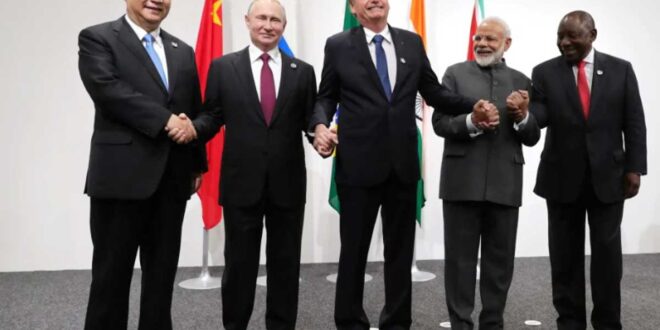Meanwhile the downfall for us dollar remains work in progress. The US dollar is continuously facing backlash. Now Russia thinks that BRICS should do more. It has floated the idea of common currency. The first indication came in January when Russian foreign minister has issued the statement in which he says “Serious, self-respecting countries are well aware of what is at stake, and want to create their own mechanisms to ensure sustainable development. It is in this direction that have been voiced recently about the need to think about creating our own currencies within the framework of BRICS.” This idea is now gathering steam. Reports say that they are working on a proposal which is likely to be presented at August that’s when BRICS summit will be held in South Africa.
Background
BRICS is an acronym that stands for an association of five major emerging national economies: Brazil, Russia, India, China, and South Africa. The term BRIC was initially coined in 2001 by Jim O’Neill, an economist at Goldman Sachs, to refer to the four countries of Brazil, Russia, India, and China, which were expected to become dominant suppliers of manufactured goods, services, and raw materials by the mid-21st century. In 2010, South Africa was included in the group, and the acronym was changed to BRICS. The five countries are all members of the G-20, and together, they represent about 42% of the world’s population, 23% of global GDP, and 17% of world trade. The BRICS countries cooperate in various areas, such as trade, investment, finance, and technology, and they hold summits annually to discuss issues of mutual interest. The BRICS countries have been exploring ways to challenge the dominance of the US dollar in international trade and finance. One of the ways they are doing this is by increasing the use of their own currencies in trade with each other. In 2014, the BRICS countries established the New Development Bank (NDB), which is aimed at providing an alternative source of funding for infrastructure projects in developing countries. The bank is capitalized with $100 billion, with each of the five member countries contributing an equal share of $20 billion. In addition, the BRICS countries have been pushing for reforms to the International Monetary Fund (IMF) and the World Bank to give emerging economies greater representation and voting power. They have also been calling for the creation of a new international reserve currency that would be less dependent on the US dollar.
Why the need to create a new currency?
Russia has been pushing the idea to create common currency among BRICS members since last year. Russian president backs the idea. Last year he said” The matter of creating the international reserve currency based on the basket of currencies of our countries is under review. Russia has its own reasons to push for this. It is under western sanctions, its access to global banking system has been limited, it also cannot use the Us dollars freely so it is pushing for a new global reserve currency and the other members of the BRICS also seem opened to the idea as they too wanted to challenge the dollars hegemony. A Russian lawmaker Alexander Babakov, the deputy chairman of Russia’s state Duma which is the lower house of Russian parliament shared the way forward. Babakov in his statement highlighted the fact that India and Russia currently one of largest emerging economies in the world would both benefit from the creation of a common currency that could be used for payments, calling it the “most viable” route to take at this time. “New Delhi, Moscow should establish a new economic alliance with a new shared currency, which could be a digital ruble or Indian rupee,”Babakov said. He further noted that China will also play a key role in the development of the common currency as it adds 1.4 billion more participants to the system.
The Russian lawmaker further stated that the transition to settlements in national currencies is the first step. The next one is to provide circulation of digital or any other form of fundamentally new currency in the nearest future. Some of this is already happening. For example, the settlement of trade in National currency. India has an agreement with Russia. It’s called the Rupee-Rubble mechanism where India pays for Russian goods in rupees and Russia earns in Rubbles. They do this with the help of special Vostro accounts and this has led to a boost in bilateral trade. According to statistics, in 2022 India’s trade with Russia touched the record which was valued at $30 billion dollars. This is belief to be an all-time high. Ofcourse the surge was fueled by oil purchases but the Russia has more expectations from India. It is banking on India for more support. Why the support? Infact Russian president Vladmir Putin has unveiled his view in foreign policy. The published new guidelines in Moscow a handbook for Russian diplomats says, Russia will continue to build up a particularly privileged strategic partnership with the Republic of India with a view to enhance and expand cooperation in all areas of mutually beneficial basis.
Russia has still a hope from China. The plan that the BRICS currency cannot materialize without help from India and China. Russia needs support from both of them and it’s not going to be an easy. Even former Goldman Sachs chief economist Jim O’Neill, who coined the acronym BRIC, has called for the BRICS bloc to expand and challenge the dominance of the US dollar as a way to combat the destabilizing effects that dollar dominance has on their monetary policy. He wrote in an article published in the journal Global Policy. “The US dollar plays too dominant a role in global finance. Whenever the Federal Reserve Board has embarked on a period of tightening or, conversely, easing, the consequences for the value of the dollar and the knock-on effects have been dramatic. O’Neill sees dollar dominance as a burden for countries with dollar-denominated debt, as their monetary policy is destabilized by exchange rate fluctuations.
Conclusion:
The strength of the Russian ruble following harsh sanctions by the US and other European countries shows that there is a high level of opposition to the hegemony of the USD, and the BRICS countries see this as an opportunity to capitalize on the growing level of discontent toward the U.S.
 Geostrategic Media Political Commentary, Analysis, Security, Defense
Geostrategic Media Political Commentary, Analysis, Security, Defense





